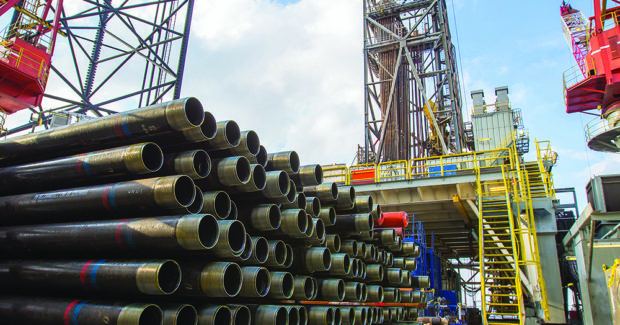Drilling Down: The Quiet Reshaping of the Energy Business
The success of shale gas has positioned the U.S. to become the world’s largest liquified natural gas exporter. This is great news for fabricators that supply parts and assemblies to the oil and gas industry, because greater gas exports mean an increase in production of storage units and infrastructure improvements that include natural gas pipelines and facilities for liquefying natural gas for export.
Posted: January 12, 2018
Metal fabricators have been keeping their eyes on a quiet revolution that has reshaped the energy business in the U.S. over the last few years. The success of shale gas – natural gas that is trapped inside dense sedimentary rock formations or shale formations – has transformed our domestic energy supply with a potentially inexpensive and abundant new source of fuel for the world’s largest energy consumer.1 With the advent of hydraulic fracturing (“fracking”), a method used to extract natural gas by blasting underground rock formations with a mixture of water, sand and chemicals, shale gas production is now booming in the U.S. Coupled with sophisticated horizontal drilling equipment that can drill and extract gas from shale formations, this technology is being hailed as a breakthrough in U.S. energy supplies, playing a key role in boosting domestic natural gas reserves. The result? Natural gas is now available in abundance after once facing a looming deficit.1
The flow of natural gas is so strong that the U.S. is now positioning to become the world’s largest liquified natural gas (LNG) exporter. According to the U.S. Energy Information Association (EIA; Washington, DC), the U.S. exported a total of 184.3 billion cubic feet (Bcf) of LNG in 2016, with the top importers by volume being Chile, Mexico, China, India and Argentina. Those exports were more than three times larger than the level ten years ago.2 Now, Mexican demand for LNG is expected to grow from 1 Bcf per day to 8 Bcf per day. India will become a major importer of LNG as their government plans to double their share of natural gas to 15 percent in light of a pledge to reduce their carbon emissions by 2030 as much as 35 percent from 2005 levels. Though overall LNG exporting is expected to start off slow due to a temporary oversupply, Energy Ventures Analysis, Inc. (EVA; Arlington, VA) forecasts that a long-term second wave of projects will move forward after 2023 and establish the U.S. as the world’s largest LNG exporter by 2030.2
This is great news for metal fabricators, because greater gas exports mean an increase in production of storage units and infrastructure improvements that include natural gas pipelines and facilities for liquefying natural gas for export. In fact, according to EVA principle Michael Schaal, developing infrastructure to process and bring LNG to market is the biggest issue. More LNG export terminals and trains are planned through 2020, potentially in Oregon and Texas. There is also an expectation of increased drilling to bring more U.S. production online, from 102 gas rigs to 149 gas rigs.2 That’s not all, because the glut of gas now being pumped from U.S. shale fields is fueling a power-plant construction boom in several Northeastern states, despite fierce competition that has caused wholesale electricity prices to plummet.3
LOCATION, LOCATION, LOCATION: GO WITH THE FLOW
The key for electricity producers is location. Having access to transmission lines to move megawatts to market is vital, but in addition, by building close to natural gas reserves power producers can more easily access cheap fuel supplies. For example, in Pennsylvania and Ohio, which sit above the prolific Marcellus Shale formation, Invenergy LLC (Chicago, IL) and Calpine Corporation (Houston, TX) are among the companies building gas-fired power plants capable of generating a combined 8.6 gigawatts when they come online between now and 2020, according to federal data.3 That output, which is enough to power up to 8.6 million homes, will require about 1.5 Bcf/d – roughly the equivalent of the daily flow through a major pipeline. This sort of economics is compelling for gas-fired power: these power plants are being built as American shale drillers continue pumping so much gas that the price of the fuel has plunged from highs of over $13 per million Btu in 2008 to less than $3 per million Btu today.3
The power from Marcellus Shale is bound for the PJM Interconnection LLC power grid that serves some or all of 13 states, including Illinois, Michigan and New Jersey, as well as Ohio and Pennsylvania. Competition among wholesale power producers in the PJM market is so fierce that a megawatt hour recently traded at its lowest level in 18 years.3 Though electricity demand remains stagnant overall, the closing of aging coal plants across the U.S. has left some regions in need of new generating capacity, and the PJM grid sits at the top of the list. Nearly 9.3 gigawatts of coal-fired electric generation have been retired in the past three years on the grid, while 8.7 gigawatts of gas-fired capacity have been added in that period. An additional 12.5 gigawatts of gas-fired generation is currently under construction and expected online through 2020.3
Power producers say these new plants make sense – despite the heightened competition – because technological advances have made them more efficient. A $1 billion gas-fired plant being built by Caithness Energy, LLC (New York, NY) in northeast Pennsylvania will be capable of generating more than one gigawatt of electricity.3 Expected to come online in May 2018, it will be supplied with gas pumped by Cabot Oil & Gas Corporation (Houston, TX), whose Marcellus drilling operations are concentrated in the same area. “We can buy the gas at a reasonable price because the producers are avoiding transportation costs they otherwise would incur to move it further,” said Ross Ain, the executive vice president for Caithness.3 The cheap supplies of gas that are coming out of shale fields were also a draw for Calpine, which expects to bring on another new facility in Pennsylvania next year that is capable of generating more than 800 megawatts. “We recognize that the abundance of domestic shale natural gas is expected to keep prices low for the foreseeable future,” stated the company. “We are well positioned to take advantage of that trend.”3
Building gas pipelines to transport fuel from places like Pennsylvania to other regions can be difficult, and Marcellus gas producers say the new power plants provide an alternative market. In addition to the 8.6 gigawatts of natural gas electricity already under construction in Pennsylvania and Ohio, companies have proposed an additional 8.2 gigawatts in those states plus West Virginia, according to federal data.3
As U.S. shale operators lead the way with new, more efficient production technologies, global oil consumption is expected to rise at record levels in 2018. In spite of the lip service given to electric cars and solar power plants, the International Energy Agency (Paris, France) says global crude consumption will top 100 million barrels per day for the first time in 2018.4 The U.S. remains a massive importer of crude oil, but now, as the world’s top net exporter of fuel, American refineries are re-exporting much of that oil as jet fuel, diesel and gasoline. Total U.S. crude oil production averaged around 9.3 million barrels per day in 2017, but due to rising demands from overseas the EIA expects oil production to increase to a record average 9.9 million barrels per day in 2018.2 To reach this demand, drilling operations will demand certified oilfield tools that are traceable to material and heat treatment, fast delivery to the rig, knowledgeable sales people and quick turnaround on quotes.
References
- “Oil & Gas Industry Outlook – July 2017,” Nilanjan Choudhury, Zacks Industry, July 20, 2017. Retrieved from Nasdaq.com.
- “American Oil and Natural Gas Opportunity,” Kaylee Swearingen, Mazak Optonics Corporation, August 31, 2017. Retrieved from www.mazakoptonics.com.
- “Power Plants Arise Near Natural Gas,” Erin Ailworth, The Wall Street Journal, December 29, 2017. Retrieved from www.wsj.com.
- “2018 Drilling Outlook & Forecast for Oilfield Tools,” Keystone Energy Tools LLC, December 19, 2017. Retrieved from www.keystoneenergytools.com.
“All of these factors together paint a better outlook for those tube and pipe fabricators who have continued to retain relationships with the oil producers during what has been a rough period,” notes Ed Youdell, the president of the Fabricators & Manufacturers Association International (FMA; Elgin, IL).2 “There is no way around using steel tube and pipe to extract oil out of the ground. As global demand rises, I remain optimistic for fabricators who play a key role in the supply chain for oil production. The hard data that stands out to me comes from the U.S. Energy Information Administration’s latest report that highlights global demand for energy resources will be increasing by 48 percent over the next 30 years.”2
Job shops, metal service centers, contract manufacturers, OEMs and other fabricators that supply parts and assemblies to the oil and gas industry see all of these trends as big opportunities to grow their business, but competition can be brutal. To help them stay competitive on job bidding, here is some of the latest fabrication equipment to help them reduce operating cycles, save time and labor, and turn jobs around quicker:
High Production Tube Fabrication
The TL 2665-FL from LVD Strippit efficiently processes round, rectangular, square or other standard tube profiles in lengths up to 26 ft in a range of materials and at optimal speeds using a 2 kW fiber laser.
Innovative, High Productivity Fiber Laser Tube Cutting
The TruLaser Tube 5000 fiber laser tube cutting machine from TRUMPF is the first tube cutting machine with a solid-state laser to eliminate the need for a fully enclosed housing, making it quick and easy to load individual tubes and profiles or to remove finished parts while the machine is in operation.
Automatic Band Saws for High Cutting Performance with Low Material and Energy Consumption
Fully automatic KASTOwin band saws from KASTO are ideal for flexible production sawing of solid materials, tubes and profiles used in mechanical engineering, toolmaking, steel, automotive and aerospace work.
Band Saw Blade Effectively Cuts Large Metal Beams, Heavy Walled Tubes
Engineered to cut structural steel, tubing and bundles, large metal beams and heavy walled tubes, the HRX Bi-Metal Band Saw Blade from LENOX makes straight cuts through wide cross-sections with minimal breaks and limited pinching in larger beams.
Economical Processing of Sheet and Plate Material
Advanced laser cutting systems and press brakes from Bystronic can process brass up to 5/8 in thick, mild steel up to one inch thick, and aluminum and stainless up to 1.180 in thick, all with impressive quality and precision to the outermost edges of the metal sheet.
Top-Loading Oven for Testing Oil Field Downhole Equipment
No. 868 is a special 500 deg F high temperature top-loading oven from Grieve with an inside workspace of 185 in W x 18 in D x 24 in H that features 34.8 kW installed in Nichrome wire heating elements and two 2 hp recirculating blowers providing 4,000 CFM of total horizontal front to rear airflow.
Multi-Tasking Dual Station Abrasive Pipe Notcher Increases Shop Productivity
The JET Dual Station Abrasive Pipe Notcher from JPW Industries uses an innovative two-station design for quick and easy access to notching, grinding and deburring at three different work stations. Seven interchangeable rollers come standard and require no tools to install.
Plasma Cutting Consumables Significantly Reduce Grinding Time
FlushCut consumables from Hypertherm use an angled nozzle bore to deliver the plasma arc at a 45 deg angle nearly parallel to the workpiece for closer cuts that dramatically reduce the amount of material left behind and significantly reduce grinding time.
Configurable, Low-Tonnage Servo-Hydraulic Press Brakes
Configurable, low-tonnage servo-hydraulic Blaise press brakes from Pacific Press deliver exacting bend tolerances and rugged reliability, using trunnion-mounted cylinders for longer, more accurate bends up to the full length of the ram and a two-stage ram drop speed to reduce bending time and shorten higher-quantity runs.











